Urban Ecological Environment Quality Evaluation and Territorial Spatial Planning Response: Application to Changsha, Central China
Abstract
1. Introduction
2. Materials and Methods
2.1. Description of the Study Area
2.2. Data Source and Processing
2.3. Methods
2.3.1. RSEI Calculation
- (1)
- Normalized difference vegetation index
- (2)
- Land surface moisture
- (3)
- Normalized difference building–soil index
- (4)
- Land surface temperature
2.3.2. RSEI Evaluation Model
3. Results and Analysis
3.1. Principal Component Analysis Results of RSEI
3.2. Analysis of Spatial-Temporal Changes in the EEQ of Changsha
3.3. Analysis of Spatial and Temporal Differences in the EEQ of Changsha
4. Discussion
4.1. Impact of Urbanization Process on the EEQ of Changsha
4.2. Impact of Industrial Land Expansion on the EEQ of Changsha
4.3. Impact of Territorial Spatial Planning on the EEQ of Changsha
4.4. EEQ Development Trend of Changsha
4.5. Strengths and Limitations
5. Conclusions
Author Contributions
Funding
Institutional Review Board Statement
Informed Consent Statement
Data Availability Statement
Acknowledgments
Conflicts of Interest
References
- Xu, J.H.; Zhao, Y.; Sun, C.G.; Liang, H.B.; Yang, J.; Zhong, K.W.; Li, Y.; Liu, X.L. Exploring the Variation Trend of Urban Expansion, Land Surface Temperature, and Ecological Quality and Their Interrelationships in Guangzhou, China, from 1987 to 2019. Remote Sens. 2021, 13, 1019. [Google Scholar] [CrossRef]
- Lin, M.X.; Lin, T.; Sun, C.G.; Jones, L.; Sui, J.L.; Zhao, Y.; Liu, J.K.; Xing, L.; Ye, H.; Zhang, G.Q.; et al. Using the Eco-Erosion Index to assess regional ecological stress due to urbanization—A case study in the Yangtze River Delta urban agglomeration. Ecol. Indic. 2020, 111, 106028. [Google Scholar] [CrossRef]
- Song, Y.M.; Chen, B.; Kwan, M.P. How does urban expansion impact people’s exposure to green environments? A comparative study of 290 Chinese cities. J. Clean Prod. 2020, 246, 119018. [Google Scholar] [CrossRef]
- Wei, F.L.; Li, S.; Liang, Z.; Huang, A.Q.; Wang, Z.; Shen, J.S.; Sun, F.Y.; Wang, Y.Y.; Wang, H.; Li, S.C. Analysis of Spatial Heterogeneity and the Scale of the Impact of Changes in PM2.5 Concentrations in Major Chinese Cities between 2005 and 2015. Energies 2021, 14, 3232. [Google Scholar] [CrossRef]
- Haas, J.; Ban, Y.F. Urban growth and environmental impacts in Jing-Jin-Ji, the Yangtze, River Delta and the Pearl River Delta. Int. J. Appl. Earth Obs. Geoinf. 2014, 30, 42–55. [Google Scholar] [CrossRef]
- Guo, L.J.; Liu, R.M.; Men, C.; Wang, Q.R.; Miao, Y.X.; Shoaib, M.; Wang, Y.F.; Jiao, L.J.; Zhang, Y. Multiscale spatiotemporal characteristics of landscape patterns, hotspots, and influencing factors for soil erosion. Sci. Total Environ. 2021, 779, 146474. [Google Scholar] [CrossRef]
- Yao, R.; Wang, L.C.; Huang, X.; Niu, Z.G.; Liu, F.F.; Wang, Q. Temporal trends of surface urban heat islands and associated determinants in major Chinese cities. Sci. Total Environ. 2017, 609, 742–754. [Google Scholar] [CrossRef]
- Grimm, N.B.; Faeth, S.H.; Golubiewski, N.E.; Redman, C.L.; Wu, J.G.; Bai, X.M.; Briggs, J.M. Global change and the ecology of cities. Science 2008, 319, 756–760. [Google Scholar] [CrossRef]
- Lu, L.L.; Weng, Q.H.; Guo, H.D.; Feng, S.Y.; Li, Q.T. Assessment of urban environmental change using multi-source remote sensing time series (2000–2016): A comparative analysis in selected megacities in Eurasia. Sci. Total Environ. 2019, 684, 567–577. [Google Scholar] [CrossRef]
- Liao, W.H.; Jiang, W.G. Evaluation of the Spatiotemporal Variations in the Eco-environmental Quality in China Based on the Remote Sensing Ecological Index. Remote Sens. 2020, 12, 2462. [Google Scholar] [CrossRef]
- Ji, J.W.; Wang, S.X.; Zhou, Y.; Liu, W.L.; Wang, L.T. Spatiotemporal Change and Landscape Pattern Variation of Eco-Environmental Quality in Jing-Jin-Ji Urban Agglomeration From 2001 to 2015. IEEE Access 2020, 8, 125534–125548. [Google Scholar] [CrossRef]
- Hu, X.S.; Xu, H.Q. A new remote sensing index for assessing the spatial heterogeneity in urban ecological quality: A case from Fuzhou City, China. Ecol. Indic. 2018, 89, 11–21. [Google Scholar] [CrossRef]
- Dewan, A.M.; Yamaguchi, Y. Using remote sensing and GIS to detect and monitor land use and land cover change in Dhaka Metropolitan of Bangladesh during 1960–2005. Environ. Monit. Assess. 2009, 150, 237–249. [Google Scholar] [CrossRef] [PubMed]
- Ji, J.W.; Wang, S.X.; Zhou, Y.; Liu, W.L.; Wang, L.T. Studying the Eco-Environmental Quality Variations of Jing-Jin-Ji Urban Agglomeration and Its Driving Factors in Different Ecosystem Service Regions From 2001 To 2015. IEEE Access 2020, 8, 154940–154952. [Google Scholar] [CrossRef]
- Wang, S.X.; Yao, Y.; Zhou, Y. Analysis of Ecological Quality of the Environment and Influencing Factors in China during 2005–2010. Int. J. Environ. Res. Public Health 2014, 11, 1673–1693. [Google Scholar] [CrossRef] [PubMed]
- Zhu, D.Y.; Chen, T.; Zhen, N.; Niu, R.Q. Monitoring the effects of open-pit mining on the eco-environment using a moving window-based remote sensing ecological index. Environ. Sci. Pollut. Res. 2020, 27, 15716–15728. [Google Scholar] [CrossRef] [PubMed]
- Zheng, X.C.; Zou, Z.Y.; Xu, C.M.; Lin, S.; Wu, Z.L.; Qiu, R.Z.; Hu, X.S.; Li, J. A New Remote Sensing Index for Assessing Spatial Heterogeneity in Urban Ecoenvironmental-Quality-Associated Road Networks. Land 2022, 11, 46. [Google Scholar] [CrossRef]
- Zhang, J.Q.; Zhu, Y.Q.; Fan, F.L. Mapping and evaluation of landscape ecological status using geographic indices extracted from remote sensing imagery of the Pearl River Delta, China, between 1998 and 2008. Environ. Earth Sci. 2016, 75, 327. [Google Scholar] [CrossRef]
- Willis, K.S. Remote sensing change detection for ecological monitoring in United States protected areas. Biol. Conserv. 2015, 182, 233–242. [Google Scholar] [CrossRef]
- Musse, M.A.; Barona, D.A.; Rodriguez, L.M.S. Urban environmental quality assessment using remote sensing and census data. Int. J. Appl. Earth Obs. Geoinf. 2018, 71, 95–108. [Google Scholar] [CrossRef]
- Gupta, K.; Kumar, P.; Pathan, S.K.; Sharma, K.P. Urban Neighborhood Green Index—A measure of green spaces in urban areas. Landsc. Urban Plan. 2012, 105, 325–335. [Google Scholar] [CrossRef]
- Ochoa-Gaona, S.; Kampichler, C.; de Jong, B.H.J.; Hernandez, S.; Geissen, V.; Huerta, E. A multi-criterion index for the evaluation of local tropical forest conditions in Mexico. For. Ecol. Manag. 2010, 260, 618–627. [Google Scholar] [CrossRef]
- Sullivan, C.A.; Skeffington, M.S.; Gormally, M.J.; Finn, J.A. The ecological status of grasslands on lowland farmlands in western Ireland and implications for grassland classification and nature value assessment. Biol. Conserv. 2010, 143, 1529–1539. [Google Scholar] [CrossRef]
- Shamshirband, S.; Nodoushan, E.J.; Adolf, J.E.; Manaf, A.A.; Mosavi, A.; Chau, K.W. Ensemble models with uncertainty analysis for multi-day ahead forecasting of chlorophyll a concentration in coastal waters. Eng. Appl. Comp. Fluid Mech. 2019, 13, 91–101. [Google Scholar] [CrossRef]
- Xu, H.Q. Analysis of Impervious Surface and its Impact on Urban Heat Environment using the Normalized Difference Impervious Surface Index (NDISI). Photogramm. Eng. Remote Sens. 2010, 76, 557–565. [Google Scholar] [CrossRef]
- Zhang, M.; Du, H.Q.; Mao, F.J.O.; Zhou, G.M.; Li, X.J.; Dong, L.F.; Zheng, J.L.; Zhu, D.E.; Liu, H.; Huang, Z.H.; et al. Spatiotemporal Evolution of Urban Expansion Using Landsat Time Series Data and Assessment of Its Influences on Forests. ISPRS Int. Geo-Inf. 2020, 9, 64. [Google Scholar] [CrossRef]
- Wen, X.L.; Xu, H.Q. Remote sensing analysis of impact of Fuzhou City expansion on water quality of lower Minjiang River, China. Sci. Geogr. Sin. 2010, 30, 624–629. (In Chinese) [Google Scholar] [CrossRef]
- Chen, W.; Zhang, Y.; Pengwang, C.Y.; Gao, W.J. Evaluation of Urbanization Dynamics and its Impacts on Surface Heat Islands: A Case Study of Beijing, China. Remote Sens. 2017, 9, 453. [Google Scholar] [CrossRef]
- Xu, H.Q. A remote sensing urban ecological index and its application. Acta Ecol. Sin. 2013, 33, 7853–7862. (In Chinese) [Google Scholar] [CrossRef]
- Zheng, Z.H.; Wu, Z.F.; Chen, Y.B.; Yang, Z.W.; Marinello, F. Exploration of eco-environment and urbanization changes in coastal zones: A case study in China over the past 20 years. Ecol. Indic. 2020, 119, 106847. [Google Scholar] [CrossRef]
- Zhang, T.; Yang, R.Q.; Yang, Y.B.; Li, L.; Chen, L.Q. Assessing the Urban Eco-Environmental Quality by the Remote-Sensing Ecological Index: Application to Tianjin, North China. ISPRS Int. Geo-Inf. 2021, 10, 475. [Google Scholar] [CrossRef]
- Wen, X.L.; Ming, Y.L.; Gao, Y.G.; Hu, X.Y. Dynamic Monitoring and Analysis of Ecological Quality of Pingtan Comprehensive Experimental Zone, a New Type of Sea Island City, Based on RSEI. Sustainability 2020, 12, 21. [Google Scholar] [CrossRef]
- Zhou, M.M.; Yang, Y.Q. Evaluation of ecological situation in Dongguan city based on remote sensing. Guangdong Agric. Sci. 2018, 45, 126–134. (In Chinese) [Google Scholar] [CrossRef]
- Song, H.M.; Xue, L. Dynamic monitoring and analysis of ecological environment in Weinan City, Northwest China based on RSEI model. Chin. J. Appl. Ecol. 2016, 27, 3913–3919. (In Chinese) [Google Scholar] [CrossRef]
- Ariken, M.; Zhang, F.; Liu, K.; Fang, C.L.; Kung, H.T. Coupling coordination analysis of urbanization and eco-environment in Yanqi Basin based on multi-source remote sensing data. Ecol. Indic. 2020, 114, 106331. [Google Scholar] [CrossRef]
- Airiken, M.; Zhang, F.; Chan, N.W.; Kung, H.T. Assessment of spatial and temporal ecological environment quality under land use change of urban agglomeration in the North Slope of Tianshan, China. Environ. Sci. Pollut. Res. 2022, 29, 12282–12299. [Google Scholar] [CrossRef]
- Maity, S.; Das, S.; Pattanayak, J.M.; Bera, B.; Shit, P.K. Assessment of ecological environment quality in Kolkata urban agglomeration, India. Urban Ecosyst. 2022, 25, 1137–1154. [Google Scholar] [CrossRef]
- Xu, H.Q.; Wang, M.Y.; Shi, T.T.; Guan, H.D.; Fang, C.Y.; Lin, Z.L. Prediction of ecological effects of potential population and impervious surface increases using a remote sensing based ecological index (RSEI). Ecol. Indic. 2018, 93, 730–740. [Google Scholar] [CrossRef]
- Yang, X.Y.; Meng, F.; Fu, P.J.; Zhang, Y.X.; Liu, Y.H. Spatiotemporal change and driving factors of the Eco-Environment quality in the Yangtze River Basin from 2001 to 2019. Ecol. Indic. 2021, 131, 108214. [Google Scholar] [CrossRef]
- Yuan, B.D.; Fu, L.N.; Zou, Y.; Zhang, S.Q.; Chen, X.S.; Li, F.; Deng, Z.M.; Xie, Y.H. Spatiotemporal change detection of ecological quality and the associated affecting factors in Dongting Lake Basin, based on RSEI. J. Clean Prod. 2021, 302, 126995. [Google Scholar] [CrossRef]
- Wang, S.T.; Ge, Y.C. Ecological Quality Response to Multi-Scenario Land-Use Changes in the Heihe River Basin. Sustainability 2022, 14, 2716. [Google Scholar] [CrossRef]
- Xiong, Y.; Xu, W.H.; Lu, N.; Huang, S.D.; Wu, C.; Wang, L.G.; Dai, F.; Kou, W.L. Assessment of spatial-temporal changes of ecological environment quality based on RSEI and GEE: A case study in Erhai Lake Basin, Yunnan province, China. Ecol. Indic. 2021, 125, 107518. [Google Scholar] [CrossRef]
- Zhang, Q.F.; Sun, C.J.; Chen, Y.N.; Chen, W.; Xiang, Y.Y.; Li, J.; Liu, Y.T. Recent Oasis Dynamics and Ecological Security in the Tarim River Basin, Central Asia. Sustainability 2022, 14, 3372. [Google Scholar] [CrossRef]
- Gao, P.W.; Kasimu, A.; Zhao, Y.Y.; Lin, B.; Chai, J.P.; Ruzi, T.; Zhao, H.M. Evaluation of the Temporal and Spatial Changes of Ecological Quality in the Hami Oasis Based on RSEI. Sustainability 2020, 12, 7716. [Google Scholar] [CrossRef]
- Qureshi, S.; Alavipanah, S.K.; Konyushkova, M.; Mijani, N.; Fathololomi, S.; Firozjaei, M.K.; Homaee, M.; Hamzeh, S.; Kakroodi, A.A. A Remotely Sensed Assessment of Surface Ecological Change over the Gomishan Wetland, Iran. Remote Sens. 2020, 12, 2989. [Google Scholar] [CrossRef]
- Jing, Y.Q.; Zhang, F.; He, Y.F.; Kung, H.T.; Johnson, V.C.; Arikena, M. Assessment of spatial and temporal variation of ecological environment quality in Ebinur Lake Wetland National Nature Reserve, Xinjiang, China. Ecol. Indic. 2020, 110, 105874. [Google Scholar] [CrossRef]
- Li, Z.W.; Zeng, G.M.; Zhang, H.; Yang, B.; Jiao, S. Integrated assessment of ecology and environment of hilly region of red soil based on GIS: A case study in Changsha. Ecol. Environ. 2004, 13, 358–361. (In Chinese) [Google Scholar]
- Goward, S.N.; Xue, Y.K.; Czajkowski, K.P. Evaluating land surface moisture conditions from the remotely sensed temperature/vegetation index measurements—An exploration with the simplified simple biosphere model. Remote Sens. Environ. 2002, 79, 225–242. [Google Scholar] [CrossRef]
- Huang, C.; Wylie, B.; Yang, L.; Homer, C.; Zylstra, G. Derivation of a tasselled cap transformation based on Landsat 7 at-satellite reflectance. Int. J. Remote Sens. 2002, 23, 1741–1748. [Google Scholar] [CrossRef]
- Baig, M.H.A.; Zhang, L.; Shuai, T.; Tong, Q. Derivation of a tasselled cap transformation based on Landsat 8 at-satellite reflectance. Remote Sens. Lett. 2014, 5, 423–431. [Google Scholar] [CrossRef]
- Xu, H.Q. A new index for delineating built-up land features in satellite imagery. Int. J. Remote Sens. 2008, 29, 4269–4276. [Google Scholar] [CrossRef]
- Shi, F.; Li, M.S. Assessing Land Cover and Ecological Quality Changes under the New-Type Urbanization from Multi-Source Remote Sensing. Sustainability 2021, 13, 11979. [Google Scholar] [CrossRef]
- Lin, Z.L.; Xu, H.Q. Ecological response analysis for urban development in an island city based on remote sensing: A case study in Xiamen island, Southeastern China. J. Fuzhou Univ. 2019, 47, 610–616. (In Chinese) [Google Scholar] [CrossRef]
- Wang, L.C.; Jiao, L.; Lai, F.B.; Zhang, N.M. Evaluation of ecological changes based on a remote sensing ecological index in a Manas Lake wetland, Xinjiang. Acta Ecol. Sin. 2019, 39, 2963–2972. (In Chinese) [Google Scholar] [CrossRef]
- Zheng, Z.H.; Wu, Z.F.; Chen, Y.B.; Yang, Z.W.; Francesco, M. Analyzing the ecological environment and urbanization characteristics of the Yangtze River Delta Urban Agglomeration based on Google Earth Engine. Acta Ecol. Sin. 2021, 41, 717–729. (In Chinese) [Google Scholar] [CrossRef]
- Lin, X.Q.; Wang, D.; Liu, X. Eco-environment response to urban spatial expansion and its driving forces in Beijing. Ecol. Environ. Sci. 2015, 24, 1159–1165. (In Chinese) [Google Scholar] [CrossRef]
- Wang, L.C.; Jiao, N.; Lai, F.B.; Dai, P.C. Study on Evaluation and Driving Forces of Ecological Changes in Jinghe County, Xin jiang. J. Ecol. Rural Environ. 2019, 35, 316–323. (In Chinese) [Google Scholar] [CrossRef]
- Hang, X.; Li, Y.C.; Luo, X.C.; Xu, M.; Han, X.Z. Assessing the Ecological Quality of Nanjing during Its Urbanization Process by Using Satellite, Meteorological, and Socioeconomic Data. J. Meteorol. Res. 2020, 34, 280–293. [Google Scholar] [CrossRef]

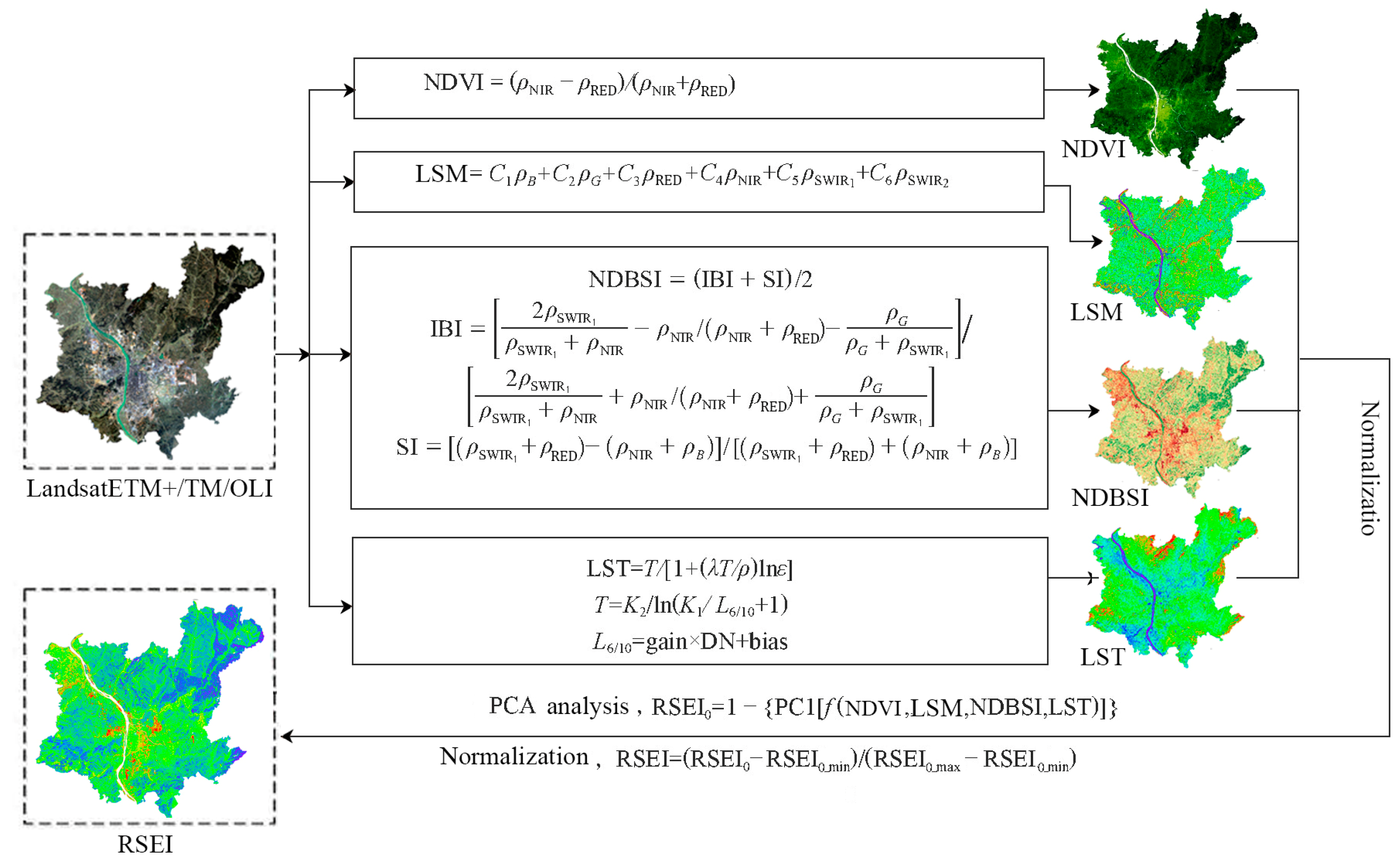
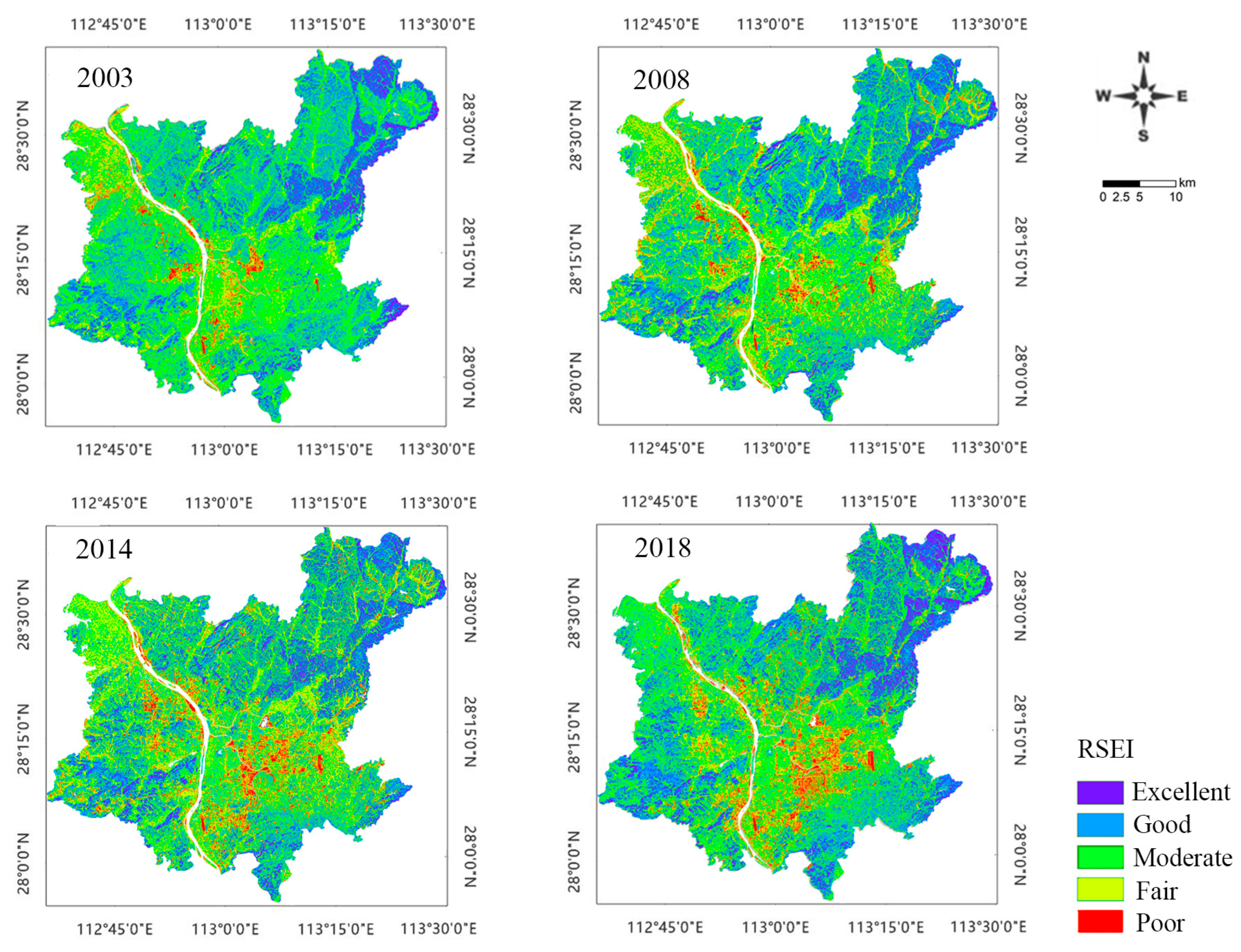
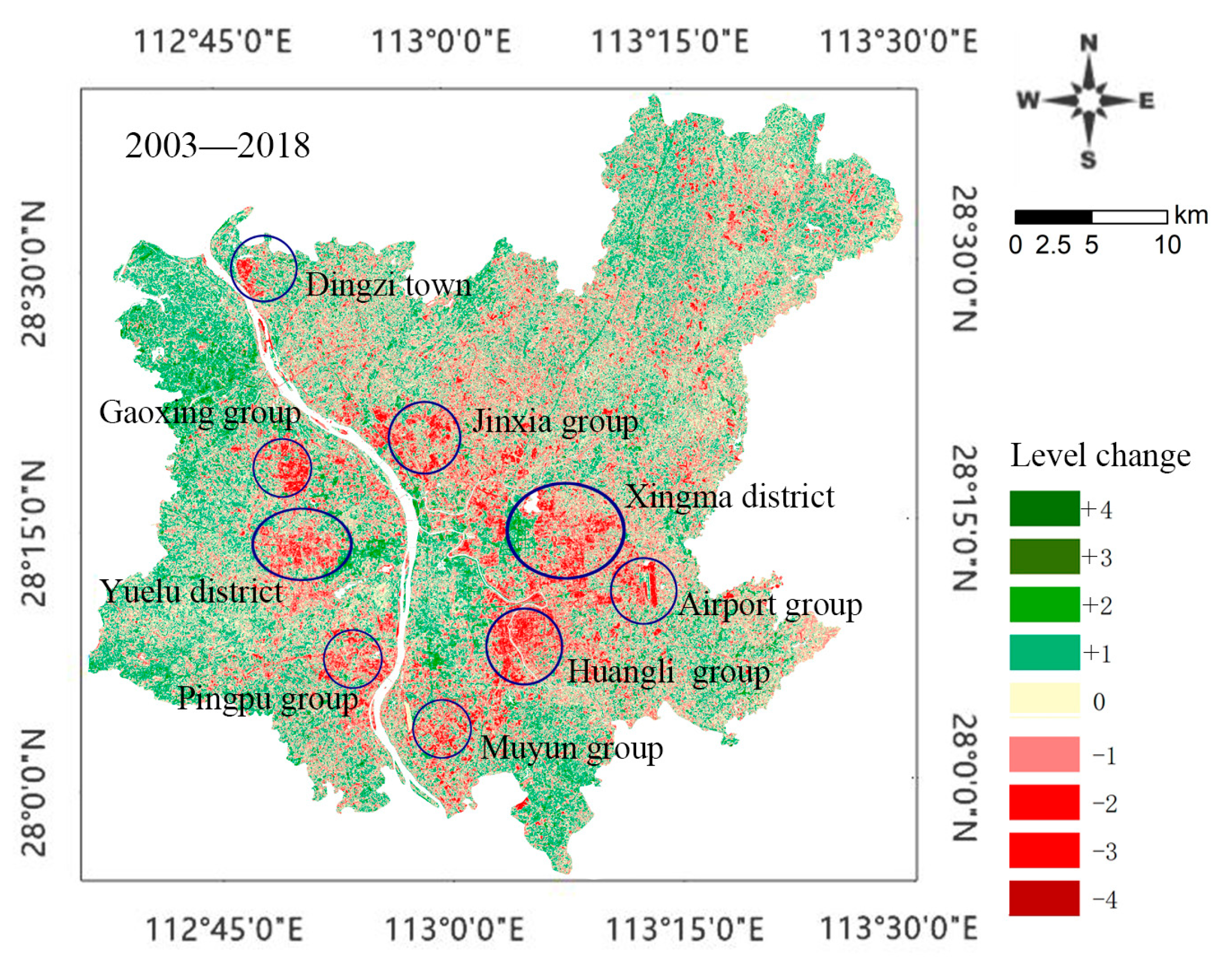
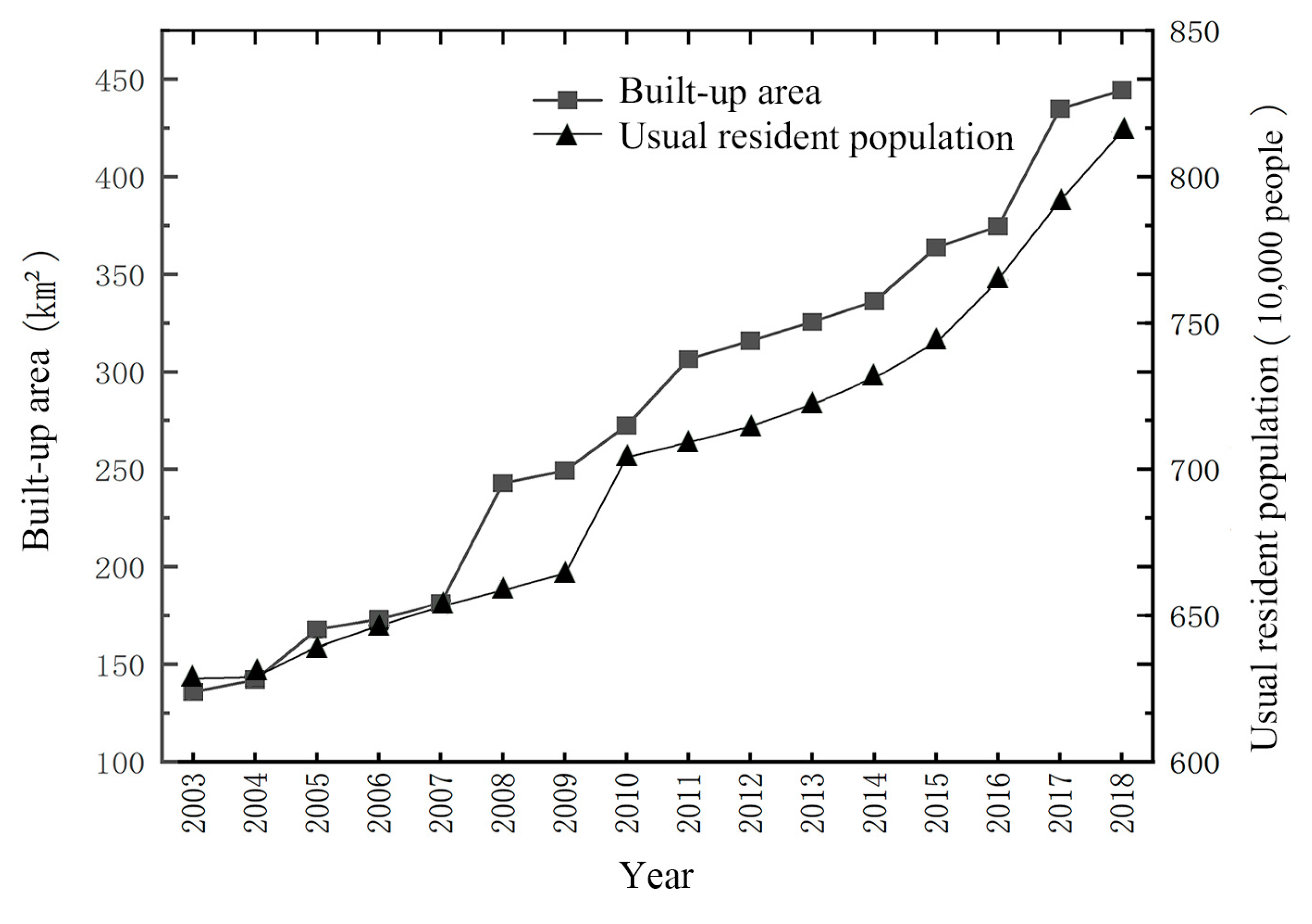
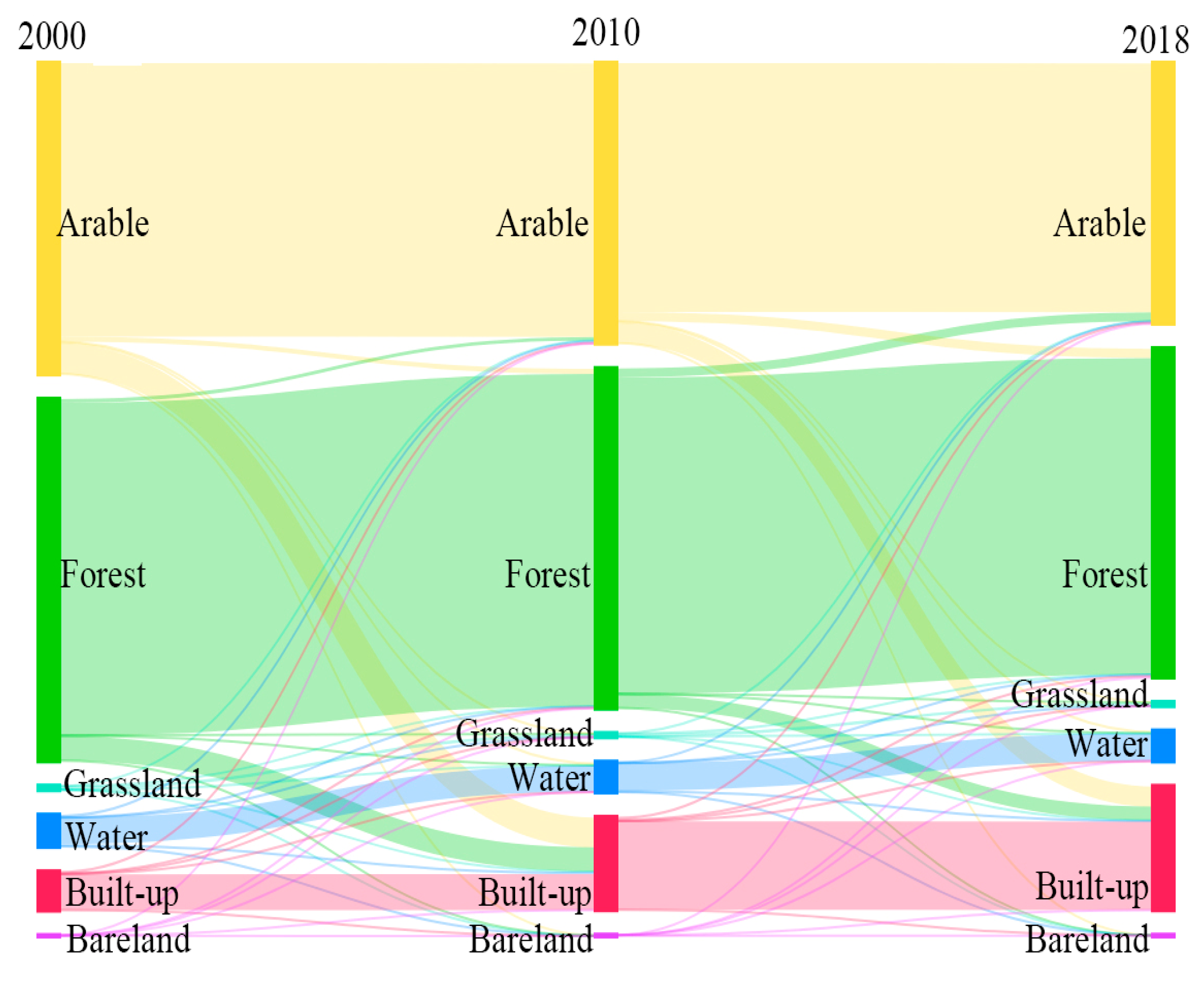
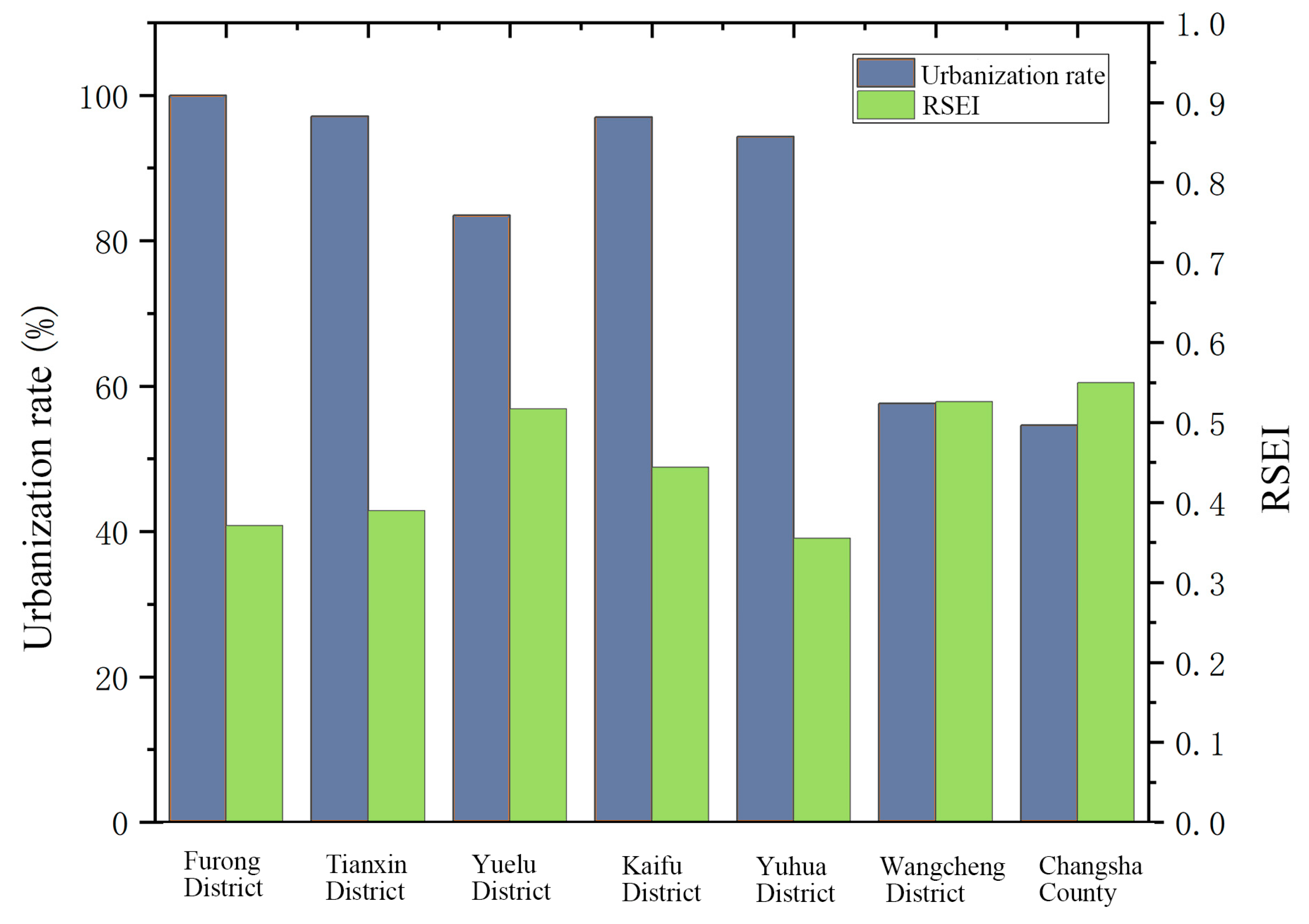
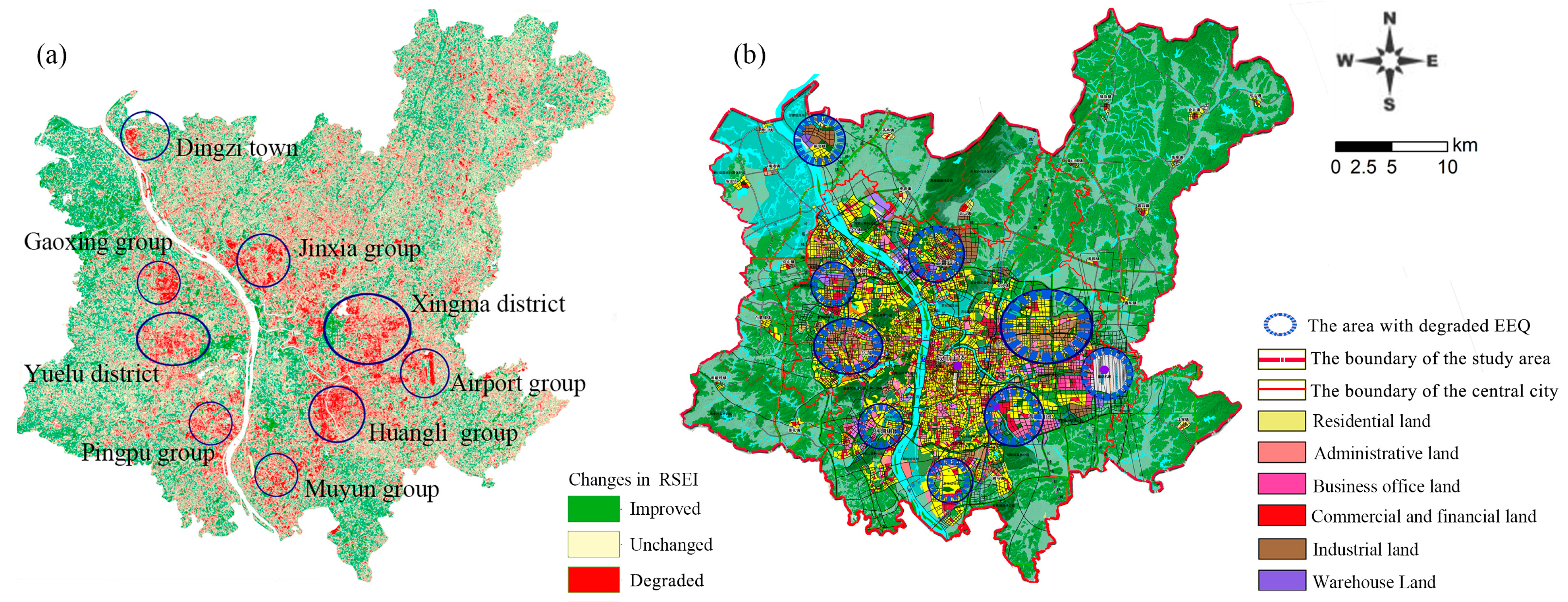
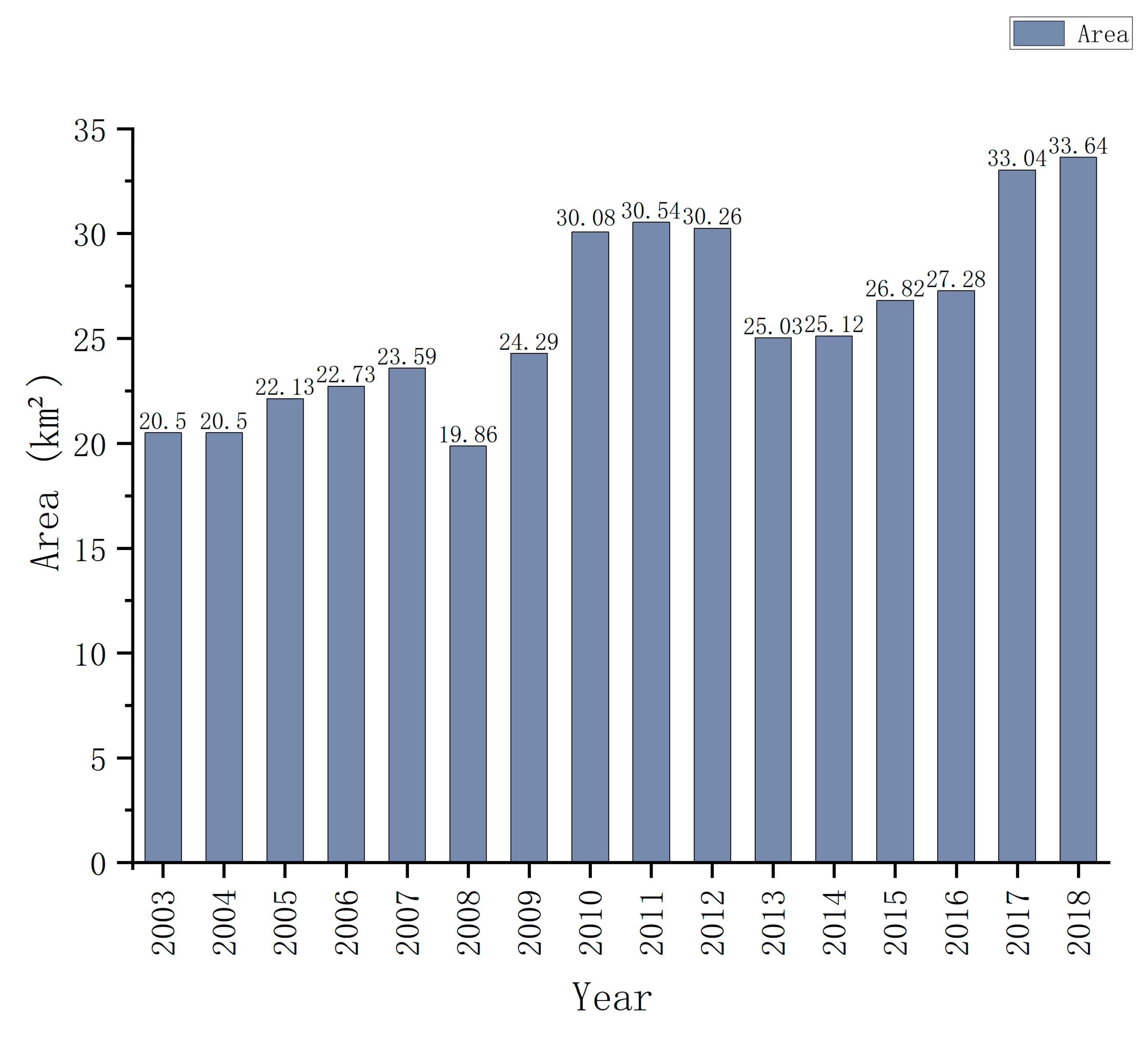
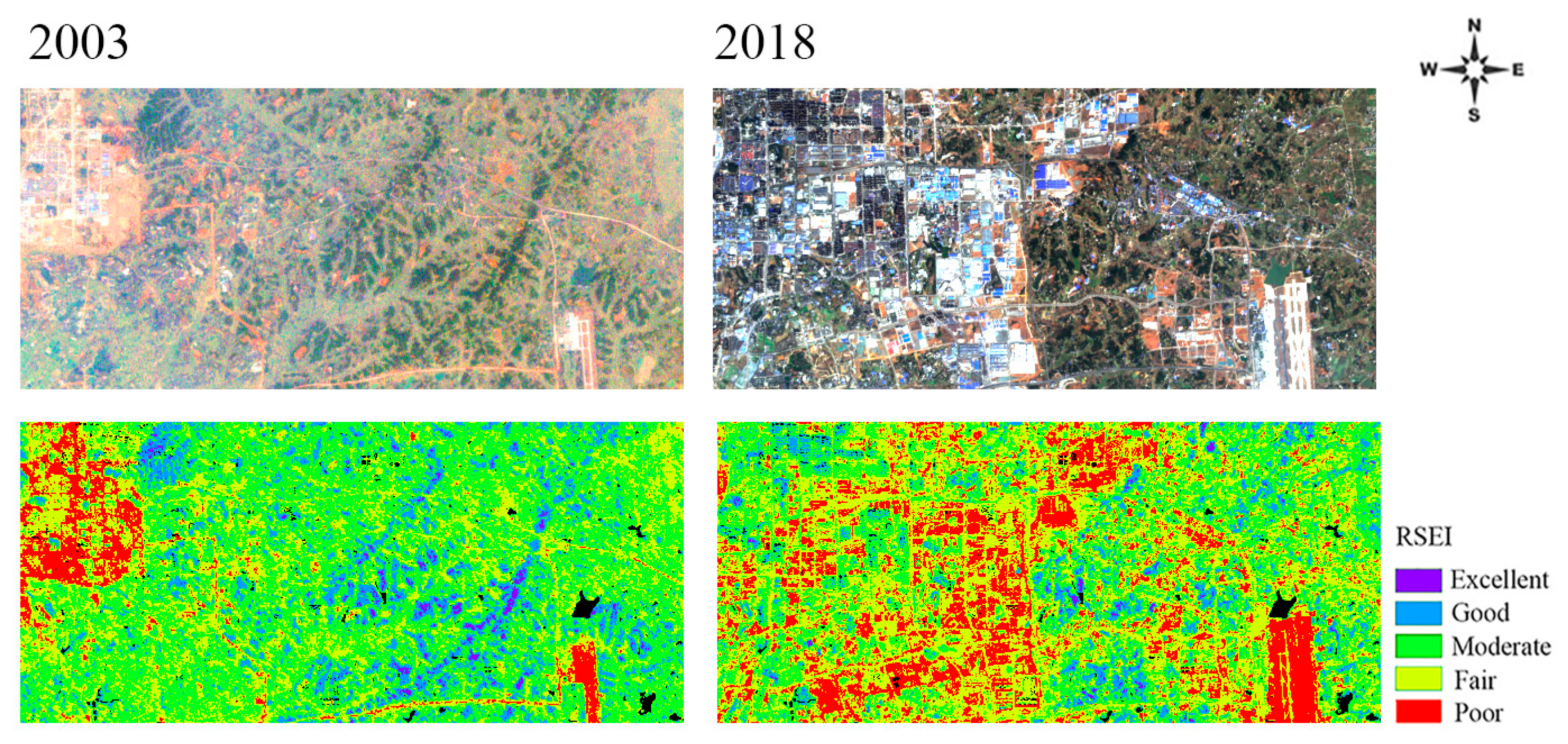
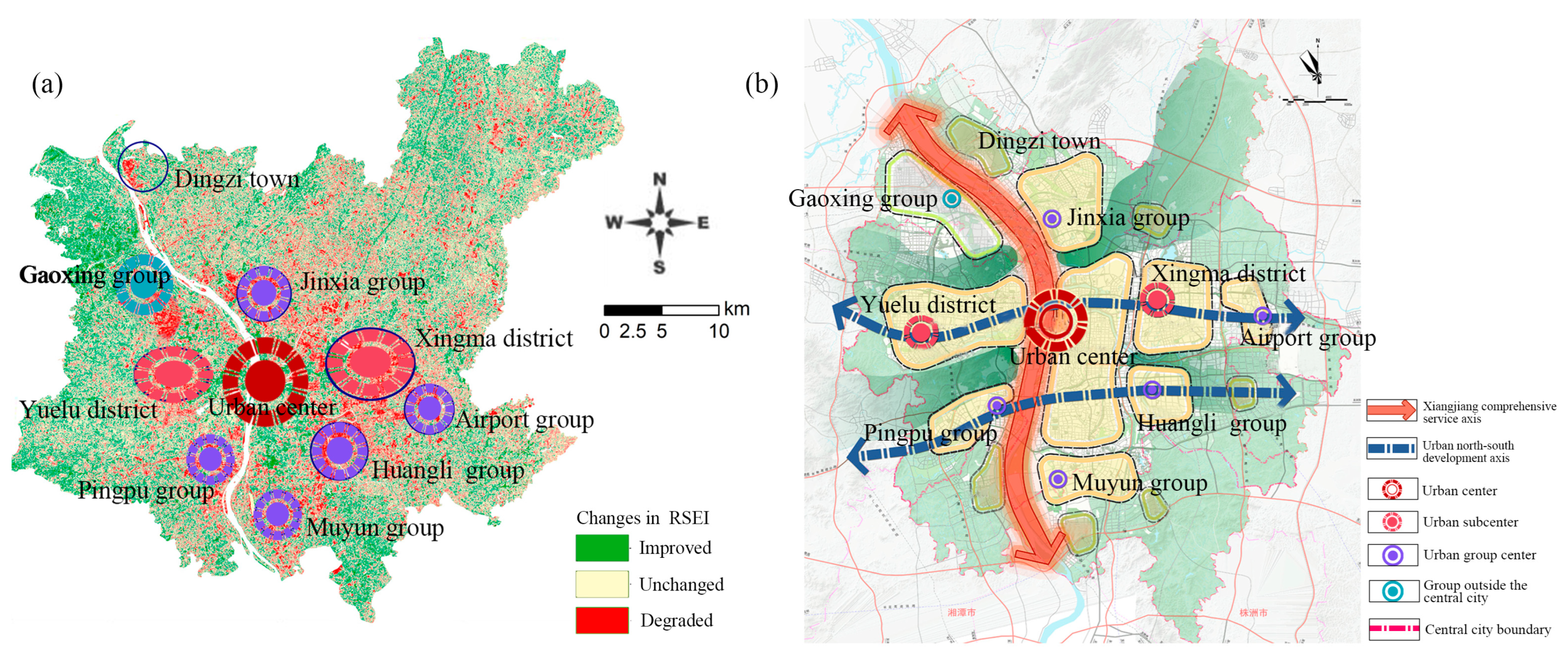
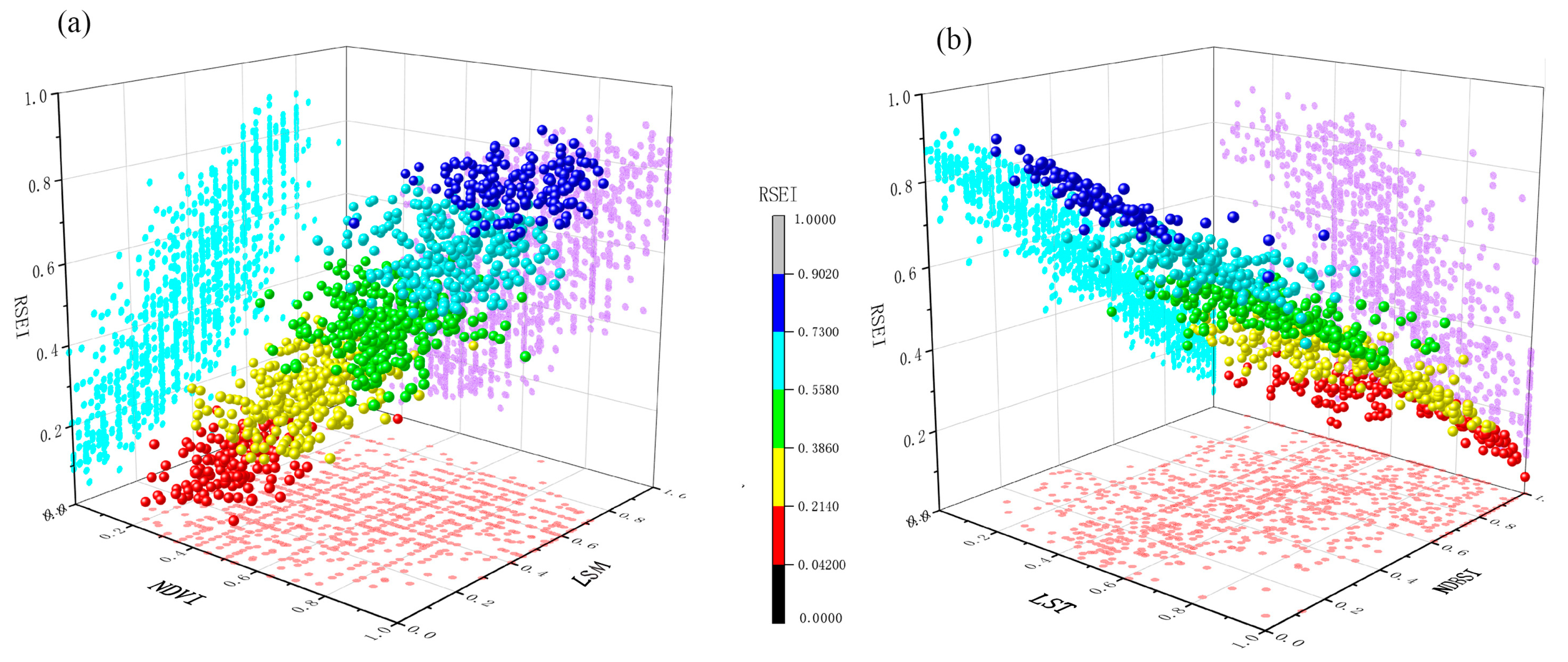
| Year | Index | PC1 | PC2 | PC3 | PC4 |
|---|---|---|---|---|---|
| 2003 | LSM | 0.470 | 0.479 | 0.662 | −0.329 |
| NDVI | 0.406 | −0.517 | −0.264 | −0.705 | |
| NDBSI | −0.776 | −0.071 | 0.342 | −0.524 | |
| LST | −0.100 | −0.705 | 0.610 | 0.345 | |
| Eigenvalues | 0.084 | 0.048 | 0.023 | 0.012 | |
| Percent eigenvalue (%) | 87.22 | 10.05 | 2.73 | 0 | |
| 2008 | LSM | 0.444 | −0.608 | 0.426 | 0.502 |
| NDVI | 0.300 | −0.056 | −0.864 | 0.399 | |
| NDBSI | −0.530 | 0.443 | 0.176 | 0.767 | |
| LST | −0.280 | −0.656 | −0.201 | 0.018 | |
| Eigenvalues | 0.310 | 0.059 | 0.028 | 0.004 | |
| Percent eigenvalue (%) | 77.31 | 14.71 | 6.98 | 1.00 | |
| 2014 | LSM | 0.421 | 0.183 | −0.674 | 0.380 |
| NDVI | 0.390 | 0.217 | 0.714 | 0.540 | |
| NDBSI | −0.584 | −0.256 | −0.171 | 0.751 | |
| LST | −0.373 | 0.924 | −0.082 | 0.006 | |
| Eigenvalues | 0.304 | 0.055 | 0.045 | 0.003 | |
| Percent eigenvalue (%) | 76.69 | 13.51 | 11.06 | 0.74 | |
| 2018 | LSM | 0.509 | 0.380 | 0.503 | 0.584 |
| NDVI | 0.317 | −0.770 | −0.287 | 0.471 | |
| NDBSI | −0.674 | 0.218 | −0.248 | 0.659 | |
| LST | −0.429 | −0.462 | 0.775 | 0.005 | |
| Eigenvalues | 0.133 | 0.036 | 0.026 | 0.001 | |
| Percent eigenvalue (%) | 86.59 | 9.87 | 3.54 | 0 |
| Year | Item | NDVI | LSM | NDBSI | LST | RSEI |
|---|---|---|---|---|---|---|
| 2003 | Mean | 0.685 | 0.503 | 0.457 | 0.514 | 0.532 |
| 2008 | Mean | 0.521 | 0.531 | 0.525 | 0.545 | 0.515 |
| 2014 | Mean | 0.491 | 0.529 | 0.584 | 0.571 | 0.500 |
| 2018 | Mean | 0.627 | 0.496 | 0.508 | 0.618 | 0.523 |
| RSEI Level | 2003 | 2008 | 2014 | 2018 | ||||
|---|---|---|---|---|---|---|---|---|
| Area (km2) | Pct. (%) | Area (km2) | Pct. (%) | Area (km2) | Pct. (%) | Area (km2) | Pct. (%) | |
| Poor (0–0.2) | 86.91 | 2.28 | 88.815 | 2.33 | 226.022 | 5.93 | 195.95 | 5.14 |
| Fair (0.2–0.4) | 768.93 | 20.13 | 1119.17 | 29.31 | 1212.39 | 31.80 | 840.59 | 22.05 |
| Moderate (0.4–0.6) | 1599.23 | 41.88 | 1195.192 | 31.30 | 1081.251 | 28.36 | 1378.50 | 36.16 |
| Good (0.6–0.8) | 1104.78 | 28.93 | 1139.93 | 29.85 | 916.401 | 24.04 | 1017.10 | 26.68 |
| Excellent (0.8–1.0) | 259.12 | 6.78 | 275.859 | 7.22 | 376.157 | 9.87 | 380.08 | 9.97 |
| Ecological Change Type | Level Change | Level Area (km2) | Category Area (km2) | Percentage (%) |
|---|---|---|---|---|
| Degraded | −4 | 0.28 | 1027.27 | 26.94 |
| −3 | 8.19 | |||
| −2 | 115.99 | |||
| −1 | 902.81 | |||
| Unchanged | 0 | 1759.21 | 1759.21 | 46.15 |
| Improved | +1 | 803.84 | 1025.74 | 26.91 |
| +2 | 190.26 | |||
| +3 | 29.59 | |||
| +4 | 2.05 |
Disclaimer/Publisher’s Note: The statements, opinions and data contained in all publications are solely those of the individual author(s) and contributor(s) and not of MDPI and/or the editor(s). MDPI and/or the editor(s) disclaim responsibility for any injury to people or property resulting from any ideas, methods, instructions or products referred to in the content. |
© 2023 by the authors. Licensee MDPI, Basel, Switzerland. This article is an open access article distributed under the terms and conditions of the Creative Commons Attribution (CC BY) license (https://creativecommons.org/licenses/by/4.0/).
Share and Cite
Lu, C.; Shi, L.; Fu, L.; Liu, S.; Li, J.; Mo, Z. Urban Ecological Environment Quality Evaluation and Territorial Spatial Planning Response: Application to Changsha, Central China. Int. J. Environ. Res. Public Health 2023, 20, 3753. https://doi.org/10.3390/ijerph20043753
Lu C, Shi L, Fu L, Liu S, Li J, Mo Z. Urban Ecological Environment Quality Evaluation and Territorial Spatial Planning Response: Application to Changsha, Central China. International Journal of Environmental Research and Public Health. 2023; 20(4):3753. https://doi.org/10.3390/ijerph20043753
Chicago/Turabian StyleLu, Chan, Lei Shi, Lihua Fu, Simian Liu, Jianqiao Li, and Zhenchun Mo. 2023. "Urban Ecological Environment Quality Evaluation and Territorial Spatial Planning Response: Application to Changsha, Central China" International Journal of Environmental Research and Public Health 20, no. 4: 3753. https://doi.org/10.3390/ijerph20043753
APA StyleLu, C., Shi, L., Fu, L., Liu, S., Li, J., & Mo, Z. (2023). Urban Ecological Environment Quality Evaluation and Territorial Spatial Planning Response: Application to Changsha, Central China. International Journal of Environmental Research and Public Health, 20(4), 3753. https://doi.org/10.3390/ijerph20043753







